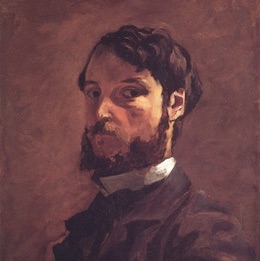Frédéric Bazille
1841 (Montpellier) / 1870 (Beaune-la-Rolande )
"You who do not know Frédéric Bazille, or you who know him imperfectly, divest yourselves of all your prejudices, and take a long look at his work," warned Gaston Poulain, the artist's biographer. Contemplating his Village View, presented at the 1869 Salon, Berthe Morisot was the first to notice: "The great Bazille is seeking what we have so often sought: to put a figure in the open air, and this time he seems to have succeeded. Sensitive to the search for the dissolution of forms in the play of light and reflection - which Monet and Renoir were doing on the banks of the Marne at the Grenouillère at the same time -, the young woman did not quite perceive the absolute novelty of the canvas, its ardent luminosity, its crudeness of colour: its " daytime power ", as the critic Zacharie Astruc later said, a true " synthesis of the Languedoc ", as Poulain analysed it too. If Bazille is indeed a precursor, it is perhaps not of Impressionism - which he never experienced - but rather of the reaction that followed it: Cézanneism, Van Gogh's Expressionism, Matisse's Fauvism and even Picasso's Cubism.
Visual:
Pierre Auguste Renoir.
Frédéric Bazille.
1867, oil on canvas, 105 x 73,5 cm.
Musée Fabre, Montpellier.
© Musée d'Orsay, Dist. RMN-Grand Palais / Patrice Schmidt
"You who do not know Frédéric Bazille, or you who know him imperfectly, divest yourselves of all your prejudices, and take a long look at his work," warned Gaston Poulain, the artist's biographer. Contemplating his Village View, presented at the 1869 Salon, Berthe Morisot was the first to notice: "The great Bazille is seeking what we have so often sought: to put a figure in the open air, and this time he seems to have succeeded. Sensitive to the search for the dissolution of forms in the play of light and reflection - which Monet and Renoir were doing on the banks of the Marne at the Grenouillère at the same time -, the young woman did not quite perceive the absolute novelty of the canvas, its ardent luminosity, its crudeness of colour: its " daytime power ", as the critic Zacharie Astruc later said, a true " synthesis of the Languedoc ", as Poulain analysed it too. If Bazille is indeed a precursor, it is perhaps not of Impressionism - which he never experienced - but rather of the reaction that followed it: Cézanneism, Van Gogh's Expressionism, Matisse's Fauvism and even Picasso's Cubism.
Visual:
Pierre Auguste Renoir.
Frédéric Bazille.
1867, oil on canvas, 105 x 73,5 cm.
Musée Fabre, Montpellier.
© Musée d'Orsay, Dist. RMN-Grand Palais / Patrice Schmidt
Artist's exhibitions
Frédéric Bazille. La jeunesse de l’impressionnisme
15/11/2016 - 05/03/2017
(Paris) Musée d'Orsay
15/11/2016 - 05/03/2017
(Paris) Musée d'Orsay
